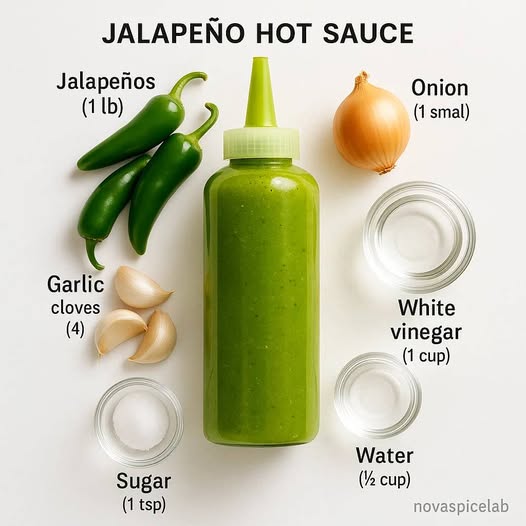Table of Contents
Table of Contents
Are you ready to move beyond mass-produced condiments and create a truly exceptional homemade hot sauce? This guide provides an in-depth look at how to craft a vibrant, fresh, and perfectly balanced easy jalapeño hot sauce using just a handful of simple ingredients. We’ll explore the science behind the heat, the history of the pepper, the role of each ingredient, and provide a comprehensive, step-by-step masterclass that will turn you into a hot sauce artisan in under an hour.
The Irresistible Allure of Homemade Hot Sauce
Why should you bother making your own when dozens of bottles line the grocery shelves? The answer lies in freshness, control, and flavor complexity. Store-bought sauces are often aged, fermented, or loaded with stabilizers, which can mute the bright, grassy, and crisp notes of the jalapeño.
Our fresh jalapeño recipe is a quick-simmer method, meaning we capture the full, vibrant essence of the pepper immediately. This results in a sauce with an unparalleled, zesty flavor that is far brighter than traditional fermented varieties. Moreover, making it at home gives you complete customization over the heat level, salt content, and final texture.
Decoding the Jalapeño: Heat, Flavor, and Origin
The jalapeño pepper (scientific name: Capsicum annuum) is perhaps the most famous chili pepper in the world. It hails from Mexico and is named after Xalapa (also spelled Jalapa), the capital city of Veracruz.
Scoville Heat Units (SHU)
The heat of any chili pepper is measured using the Scoville Scale, a unit of measurement developed by pharmacologist Wilbur Scoville in 1912. The heat comes from a compound called capsaicin, which binds to pain receptors in the mouth and throat.
Jalapeños typically range from 2,500 to 8,000 SHU. For comparison:
- Bell Pepper: 0 SHU
- Serrano Pepper: 10,000–23,000 SHU
- Habanero Pepper: 100,000–350,000 SHU
This moderate heat level is what makes the jalapeño ideal for a mass-appeal hot sauce—it’s spicy enough to be exciting but mild enough for daily use.
The Role of Ripeness
Most jalapeños are harvested when they are deep green. If left on the vine, they will eventually turn a deep red and their flavor will sweeten slightly while their heat level tends to increase. For this easy jalapeño hot sauce, we recommend using the standard, vibrant green variety to capture that signature fresh and slightly grassy note. If you want a more complex, smoky sauce, use a mix of green and red peppers.
Comprehensive Ingredient Breakdown and Selection Guide

Every ingredient in this recipe plays a crucial, synergistic role. Understanding their function is key to making a truly exceptional batch of homemade hot sauce.
1. The Core: Fresh Jalapeños
- Quantity: 1 lb (approx. 10–12 peppers), stems removed.
- Purpose: The body, flavor, and heat of the sauce.
- Selection: Look for peppers that are firm, smooth, and have a rich, uniform green color. Avoid any with soft spots or excessive wrinkling. The famous white striations (corking) are a sign of a mature, often hotter, pepper.
- Customization: Controlling the Heat: The vast majority of capsaicin resides in the placenta (the white membrane) and the seeds. To dial down the heat, slice the peppers lengthwise and scrape out all the seeds and white pith. For a hotter sauce, leave them all intact. For a moderate sauce, remove about half of the seeds.
2. The Aromatics: Garlic and Onion
- Garlic: 4 cloves. Garlic provides an essential, savory depth. We are using whole cloves, which will soften and mellow during the simmer, allowing their complex flavor compounds to blend seamlessly into the sauce.
- Small Onion: 1, chopped. The onion provides a savory foundation and a touch of sweetness when cooked. The simmering process is vital for the onion; it removes the sharp, pungent raw flavor, leaving behind only the pleasant, aromatic base notes.
3. The Liquid Base and Preservative: Vinegar and Water
The liquid components are the most important for texture, flavor balance, and shelf stability.
- White Vinegar (1 cup): This is the magic ingredient. Vinegar is a key element in all traditional hot sauces.
- Flavor Balance: Its acidity cuts through the richness of food and balances the intense heat of the capsaicin.
- Preservation: Vinegar’s low pH (typically 2.4 to 3.4) creates an environment hostile to bacteria and mold, extending the shelf life of your homemade hot sauce to several months under refrigeration.
- Alternative Vinegars: While white vinegar is recommended for its neutral flavor, you can experiment with Apple Cider Vinegar (ACV) for a fruitier, milder tang, or Distilled White Wine Vinegar for a slightly softer finish. However, stick to the clear white vinegar for this foundational recipe.
- Water (½ cup): Water helps regulate the concentration of the sauce and helps the ingredients simmer without scorching. It also contributes to the final pourable viscosity of the hot sauce. You can substitute water with vegetable or chicken stock for an even deeper umami flavor, but ensure it is low-sodium to control the salt content.
4. The Balancers: Sugar and Salt
These ingredients might seem minor, but they are absolutely critical to achieving a gourmet-level flavor profile.
- Sugar (1 tsp): Many people skip sugar in hot sauce, but it is a massive mistake. The sugar isn’t there to make the sauce sweet; it’s there to balance the acidity of the vinegar and the bitterness that can sometimes come from the pepper skins. It adds a roundness to the flavor, making the sauce more complex and appealing.
- Salt (1 tsp): Salt is a flavor potentiator. It enhances the taste of the jalapeños, garlic, and onion. Use kosher salt or fine sea salt. Avoid iodized table salt as it can sometimes impart a slightly metallic flavor.
5. The Fresh Finish (Optional Additions)
These are your signature moves—the flourishes that take the sauce from great to unforgettable.
- Lime Juice (A squeeze): Adding this at the very end (after blending) introduces a volatile, zesty note that is often missing from cooked sauces. It pairs exceptionally well with the jalapeño.
- Cilantro (A handful): This is the secret to a bright, “taco stand” style hot sauce. The herb adds a refreshing, clean, and earthy dimension that is phenomenal on Mexican food. Add it during the blending stage.
- Carrots: A common addition in many Caribbean and Central American hot sauces. Carrots add body, subtle sweetness, and a lovely orange hue. Use about half a cup, chopped, and simmer them along with the peppers and onion.
Step-by-Step Masterclass: Creating Your Easy Jalapeño Hot Sauce
This simple, four-step process requires less than 30 minutes of active preparation time.
Step 1: Pre-Preparation – Safety First
Before you start, remember the number one rule of chili preparation: Protect your skin and eyes!
- Gear Up: Put on a pair of disposable nitrile or latex gloves. Capsaicin is an oil, and soap and water struggle to remove it completely. Gloves will prevent you from accidentally touching your face or eyes later.
- Clean and Trim: Wash the jalapeños thoroughly. Slice off and discard the stems. Rough-chop the onion and peel the garlic cloves.
- Decide Your Heat: Based on your preference, remove the seeds and white membranes from the jalapeños now. Remember, the simmering process will not reduce the heat of the capsaicin—only dilution will.
Step 2: The Critical Simmer
The purpose of this step is twofold: to soften the tough ingredients (peppers and onion) and to cook out the sharp, harsh notes of the raw aromatics (garlic and onion).
- Combine: In a non-reactive saucepan (stainless steel or enameled cast iron), combine the prepared jalapeños, chopped onion, garlic cloves, white vinegar, water, sugar, and salt.
- Boil and Reduce: Bring the mixture to a rolling boil over medium-high heat. As soon as it boils, reduce the heat immediately to a gentle simmer.
- Simmer Time: Cover the pot and allow it to simmer for 10 to 15 minutes. The peppers and onions should be noticeably soft, and the liquid level will have reduced slightly. The whole mixture will smell fragrant, acidic, and subtly sweet.
- Why Simmering Matters: While fermentation takes days or weeks to create complex flavors, this quick simmer achieves a similar mellowing effect on the aromatics, creating a balanced flavor profile in minutes.
Step 3: Blending and Texturing
This is where the magic happens and your ingredients transform into a liquid fire.
- Transfer Carefully: Use a ladle or a slotted spoon to transfer the solid ingredients (peppers, onion, garlic) into a high-powered blender first, then pour in the remaining liquid.
- ABSOLUTELY CRITICAL SAFETY WARNING: Never blend hot liquids with the blender lid completely sealed. The heat creates steam, which builds pressure rapidly and can blow the lid off, resulting in a dangerous spray of scalding hot sauce.
- Vent and Blend: Remove the small plastic stopper from the center of the blender lid (the cap). Cover the hole loosely with a folded kitchen towel to catch splashes while allowing steam to escape.
- Process: Start blending on low speed, then gradually increase to high. Blend for 1 to 2 minutes until the mixture is absolutely smooth. There should be no visible chunks of pepper skin or onion.
- Add Fresh Finish: If using the optional lime juice or cilantro, add them now and blend for a final 30 seconds.
Step 4: Straining for Optimal Viscosity
Straining is an optional but highly recommended step that separates a chunky salsa-like sauce from a smooth, pourable, commercial-quality hot sauce.
- The Tool: Place a fine-mesh sieve over a clean bowl.
- The Strain: Pour the blended sauce slowly into the sieve. Use the back of a rubber spatula or a wooden spoon to press the thick pulp against the mesh. This forces the liquid through while catching any tiny bits of skin, seeds, and unblended fiber (the pomace).
- The Result: The liquid in the bowl is your smooth, silky hot sauce. Discard the pomace (the solids left in the sieve).
- Tip: If you prefer a thick, rustic sauce, skip the straining step entirely!
Step 5: Cooling and Bottling
- Cool Down: Allow the finished sauce to cool completely at room temperature. This is essential, as bottling hot sauce can create condensation inside the container, which is bad for shelf life.
- Sterilize: Sanitize your chosen bottles or jars by washing them thoroughly in hot, soapy water, rinsing, and then letting them air-dry or running them through a dishwasher’s sanitizing cycle.
- Fill and Seal: Using a funnel, pour the cooled homemade hot sauce into the sterilized bottles. Seal them tightly.
- Storage: Store the finished sauce in the refrigerator. Thanks to the high vinegar content, it will keep for up to 3 months (and often longer).
Troubleshooting and Advanced Customization
Once you’ve mastered the core easy jalapeño hot sauce recipe, you can begin to experiment with variations and fix common issues.
Common Troubleshooting Scenarios
| Issue | Cause & Solution |
| Sauce is Too Thin | Cause: Too much water/vinegar, or inadequate blending/straining. Solution: Next time, reduce the water by 1/4 cup. For the current batch, return it to the saucepan and gently simmer uncovered for 5–10 minutes to reduce and thicken, then cool and rebottle. |
| Sauce is Too Thick | Cause: Too little liquid or too much fibrous pepper material. Solution: Simply add a tablespoon of water or vinegar at a time while blending until the desired consistency is reached. |
| Too Vinegary/Sharp | Cause: Not enough balance. Solution: Add a little extra sugar (a half teaspoon at a time) or a tiny pinch of baking soda to neutralize some of the acid. |
| Not Spicy Enough | Cause: Seeds/placenta were removed. Solution: Next time, leave all seeds and membranes intact. For the current batch, you can blend in a few drops of high-quality, unflavored capsaicin extract (use with extreme caution!) or a small amount of roasted habanero or serrano for a heat boost. |
Flavor Variations for the Hot Sauce Enthusiast
- Smoky Chipotle: Before simmering, smoke the jalapeños and onion in a smoker for 20 minutes, or roast them in the oven until deeply charred. Alternatively, add 1-2 canned chipotle peppers (smoked jalapeños) in adobo sauce to the blender.
- Tropical Green Sauce: Replace the water with pineapple juice and add a slice of green bell pepper to the simmer. Blend with a large handful of cilantro and lime juice. The pineapple provides a sweet, tropical contrast.
- Umami Bomb: Add 1-2 tablespoons of soy sauce or fish sauce to the liquid during the simmer. This introduces a deep, savory, complex flavor (Umami) that is phenomenal on Asian and grilled dishes.
- Aji Verde Style: Increase the amount of cilantro to a full cup and add 1/2 cup of mayonnaise to the finished, cooled sauce before blending. This creates a creamy, Peruvian-inspired sauce often served with chicken.
Culinary Applications: How to Use Your Homemade Hot Sauce
Now that you’ve created a spectacular batch of easy jalapeño hot sauce, it’s time to unleash it on your favorite foods. Its bright, fresh profile makes it incredibly versatile.
- The Breakfast Staple: Drizzle it generously over scrambled eggs, omelets, hash browns, or a breakfast burrito.
- The Taco Topper: It is the quintessential taco sauce. Use it on fish tacos, carne asada, or al pastor for a zesty kick.
- Pizza and Pasta: Add a few dashes to pasta sauces or sprinkle it on a slice of pepperoni pizza for an acidic, spicy counterpoint to the richness.
- Cocktails: A small splash in a Margarita or a Bloody Mary is a game-changer.
- Marinating: Use it as a base for a quick chicken or shrimp marinade. The acidity of the vinegar will tenderize the meat, and the spice will infuse the flavor.
- Compound Butter: Mix a tablespoon into softened unsalted butter to create a spicy compound butter perfect for topping grilled steaks or corn on the cob.
The brilliance of this homemade hot sauce is its simplicity and vibrant flavor. It’s a testament to the fact that the best condiments are the ones you make with fresh ingredients in your own kitchen. You now have the knowledge and the recipe to permanently upgrade your spice cabinet and impress every person who tastes your easy jalapeño hot sauce. Enjoy the heat!
Make the Best Homemade Hot Sauce: Quick Jalapeño Recipe
Easy Jalapeño Hot Sauce Recipe
Ingredients
1 lb fresh jalapeños (about 10–12), stems removed
4 cloves garlic
1 small onion, chopped
1 cup white vinegar
½ cup water
1 tsp sugar (balances the sharpness)
1 tsp salt
(Optional: add a squeeze of lime juice or a handful of cilantro for a fresh twist)
Instructions
1. Prep the jalapeños
Slice them (you can keep or remove seeds depending on how hot you want it).
2. Sauté
In a saucepan, heat a little oil and sauté the onion and garlic until fragrant. Add jalapeños and cook for 5 minutes.
3. Simmer
Pour in vinegar, water, salt, and sugar. Bring to a simmer for 10 minutes until peppers are soft.
4. Blend
Carefully transfer to a blender and blend until smooth. Add more water if you prefer a thinner sauce.
5. Bottle
Pour into sterilized glass bottles or jars. Keeps in the fridge for 2–3 months.








